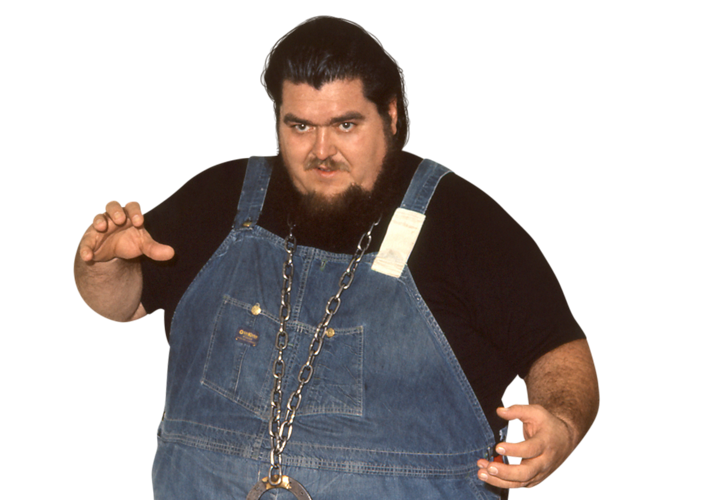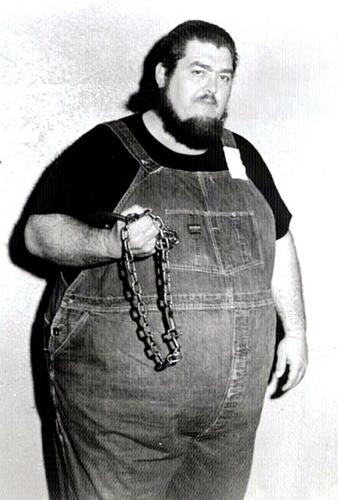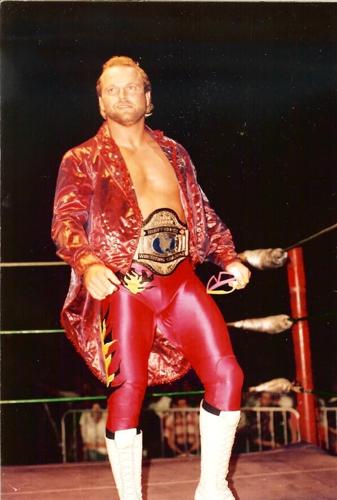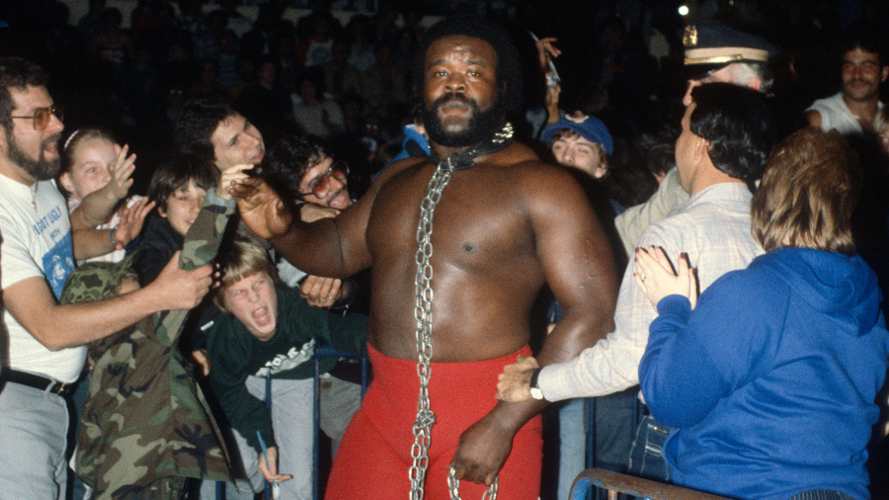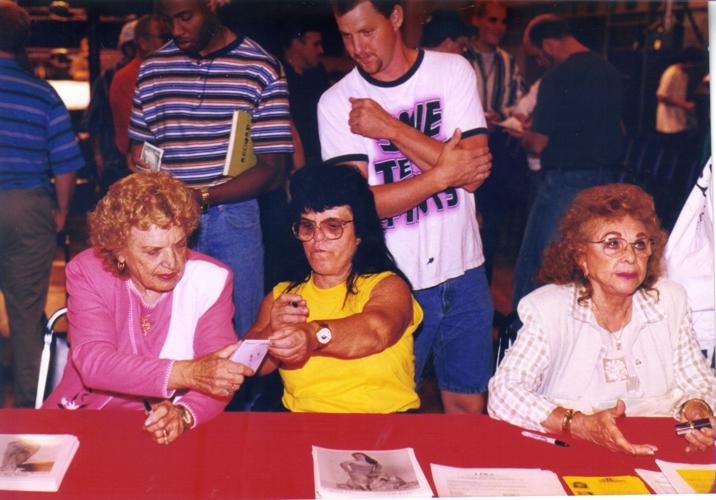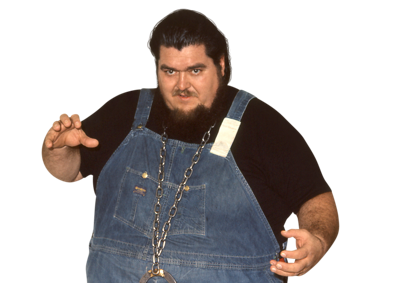With pro wrestling/sports entertainment playing to mostly empty arenas, anxiously awaiting a green light to reconnect with live audiences, it’s an ideal time to take a look back at some of the greats of yesteryear who helped paved the way for those who followed.
While grapplers like Big Show (Paul Wight) and Braun Strowman have represented some of the best super heavyweights in recent times, there have been many other giants over the years, most notably Andre The Giant, the first man inducted into WWE’s Hall of Fame in 1993. One of pro wrestling’s biggest draws and highest-paid performers during the 1970s and early ‘80s, the nearly 7-foot tall, 500-pound Andre was larger than life in terms of both his physical stature and his personality.
But before Andre, a plowboy by the name of Haystacks Calhoun (real name Bill Calhoun) toured the country as a special attraction. Billed at 601 pounds from Morgan’s Corner, Ark. (although he grew up on a farm in Texas), “Stacks” was one of the most popular “rasslers” on the circuit from the mid-1950s through the early ‘70s.
Sporting his signature white T-shirt, blue bib overalls and a lucky horseshoe strung around his neck, his enormous size, physical strength and lovable demeanor established the barefooted “Country Boy” Calhoun as a major attraction in numerous territories around the country.
While many of today’s fans might not be familiar with Calhoun, it’s interesting to note that he was posthumously inducted into the WWE Hall of Fame as part of the Legacy wing in 2017. WWE also has honored him among its 50 all-time greatest wrestlers.
He was a favorite of the late Vince McMahon Sr., who booked Calhoun on many shows at Madison Square Garden, including a famous match with Bruno Sammartino, whose strongman legend grew with the claim that he was the only man to lift Haystacks off his feet, dumping him so hard that the center of the ring caved in. Despite his program with fan favorite Sammartino, Calhoun went on to form a popular team with Bruno, as well as other stars such as Bobo Brazil and a young Tony Garea, with whom he captured the WWWF tag-team title from Mr. Fuji and Prof. Tanaka in 1973.
The mountainous man would also hold the NWA U.S. tag-team title with Jack Brisco and the WWA International tag-team title with Abe Jacobs, as well as regional tag titles with Don Leo Jonathan, The Amazing Zuma, Kevin Sullivan and Sweet Daddy Siki. Like Andre, though, he was a special attraction and big enough draw without ever having to chase a championship. He never really needed a belt to be a star.

Haystacks Calhoun with tag-team partner Jerry Brisco. Chris Swisher Collection/Provided
Routinely eating a dozen eggs for breakfast and weighing 300 pounds by the time he was 14, Calhoun was more than a mere novelty act in the wrestling business. He utilized a variety of moves in the ring, with his finishing maneuver aptly called the “big splash.” The super heavyweight even challenged NWA world champions Lou Thesz, Buddy Rogers, Pat O’Connor and Gene Kiniski.
And, much like Andre, Stacks wore custom-made clothing and even drove a custom-made station wagon to travel from town to town.
Fan favorite
For years, Stacks was as well known as anyone in the wrestling business. After appearing on the nationally broadcast Art Linkletter’s “House Party” when he showed off his strength by tossing bales of hay into a loft, the moniker “Haystacks” stuck for good. “It fit,” he would say, “and, anyway, a name like Bill would have meant death at the box office.”
Game show host Groucho Marx booked him on “You Bet Your Life.” He also was a guest on television talk shows hosted by Jack Paar and Merv Griffin. A company selling king-size beds featured Haystacks and actress Jayne Mansfield endorsing extra-firm mattresses.
Stacks even appeared on the big screen, in a 1962 bit part at the end of Rod Serling’s critically acclaimed masterpiece “Requiem for a Heavyweight.” Anthony Quinn starred in the gritty, hard-boiled melodrama as washed-up, punch-drunk prize fighter Mountain Rivera. His conniving and unscrupulous manager, played by Jackie Gleason, finds a way to squeeze a few more bucks from his career by lining him up for a professional wrestling match. The poignant closing scene features Rivera, amidst jeering ridicule, climbing into the ring across from the 601-pound Calhoun.
“Rasslin’ was a job and a good job,” Calhoun once said in an interview. “I don’t like nobody saying anything bad about rasslin.’ It took care of me for a long, long time.”
One of Stacks’ favorite territories was the Carolinas and Virginia, where with partner Johnny Weaver he established himself as a top player in the tag-team division. While the clean-shaven and athletic Weaver was the workhorse of the duo, the bushy-bearded, mammoth Calhoun provided the brawn.

Haystacks Calhoun was billed from the fictional birthplace of Morgan’s Corner, Ark. Provided photo
A grueling series of matches pitting Calhoun and Weaver against The Bolos (Tom Renesto and Joe Hamilton) set attendance records throughout the territory. Six-man matches with The Bolos and The Missouri Mauler (Larry “Rocky” Hamilton) against Calhoun and The Kentuckians (Big Boy Brown and Tiny Anderson) established attendance records in such venues as the Charlotte Coliseum, Dorton Arena in Raleigh and the Greenville Memorial Auditorium.
Hamilton recalled that he and Renesto, later known as The Assassins, helped save the job of Weaver, the territory’s top babyface during the ’60s, by pleading with promoter Jim Crockett Sr., who thought Weaver had become stale and had worn out his welcome with area fans.
The plea worked and proved to be financially advantageous to all involved. Hamilton cited a sold-out Fourth of July event at the Greensboro Coliseum that paired the two teams. The hooded duo had agreed to unmask if they were pinned or submitted two out of three falls in a one-hour match.
“We kept Weaver in the ring for 57 minutes,” said Hamilton. “He made the hot tag to Calhoun at the 57-minute mark and the crowd went wild.” Haystacks nailed both men with his belly bumps, slammed Renesto on the concrete floor and pinned him to win the first fall with less than three minutes remaining in the match.
“The people went insane,” recalled Hamilton. “We got a two-minute rest period, and I drug Tom back into the ring and raised his arm while I put my arm across the top rope. He was still prone, but he made the tag. I grabbed Tom, rolled him on to the apron and ran from Calhoun. When I kept asking the timekeeper how much time was left, the crowd was ready to jump me. We stalled until the time ran out. It took 36 cops locked arm in arm forming a V wedge to get us out of the ring and into the dressing room. We were hemmed up in the dressing room until 2 o’clock in the morning.”

Haystacks Calhoun, an oddity in a sport of oddities, was an instant hit among fans. Provided photo
Taking a toll
One of the late Andre The Giant’s favorite stories was about the time he and Haystacks went to a diner.
“There was a place next to the arena which was one of those all-you-can-eat-for-two-dollars joints,” Andre said in a 1973 interview. “When Haystacks and I walked in you could see the waitress almost faint. About 30 seconds later the manager comes out, takes a peek at us, and shakes his head and goes back to the kitchen.
“Haystacks and I decided to tie on a real big feed that night and the waitresses were hysterical. They told us the manager was tearing his hair out and practically in tears. But we felt badly, since we must’ve eaten about $25 worth of food for $4. So after it was over we told him we’d pay the regular price instead of the all-you-can-eat price. He thanked us for that and told us two more like us could put him out of business.”
While there were heavier grapplers over the years, including the 800-pound Happy Humphrey (William J. Cobb) and Billy and Benny McGuire (McCrary), listed in Guinness Book of World Records as the “World’s Heaviest Twins” at more than 700 pounds each, few reached the level of success in the business that Calhoun attained. His friendliness, down-to-earth personality and hillbilly gimmick got him over with fans, especially children, most of whom had never seen such a gigantic specimen.
Calhoun, who fought Humphrey in a series of heavily hyped matches at Madison Square Garden during the early ‘60s, was the superior of the two athletes.
“When I wrestled Happy he weighed about 700 pounds, but I could see as soon as we squared off that he was a fat 700 pounds,” Calhoun once observed. “He had very poor balance, was easy to get around and easy to handle. I slammed him easier than the average-size fellow. When I learned he was up to 800 pounds I warned him that it wasn’t healthy.”
Sadly, though, that same prognosis would befall the likable country boy Calhoun in later years. By the late ‘70s, the wrestling grind had taken a toll on Haystacks. His weight and declining health eventually forced him into retirement, and he was ultimately confined to a double-wide trailer after losing his left leg to diabetes in 1986.
His bib overalls and lucky horseshoe, among the few souvenirs he had saved from his wrestling days, were tucked away in a suitcase in his mobile home.
“The horseshoe’s back there,” the wheelchair-bound Stacks told an interviewer. “But it looks like all the luck done ran out the wrong end.”
Destitute and despondent, his ticket to fame having long been cashed, William Dee Calhoun was just 55 years old when he died on Dec. 7, 1989.
Reach Mike Mooneyham at bymikemooneyham@gmail.com, or follow him on Twitter at @ByMikeMooneyham and on Facebook at Facebook.com/MikeMooneyham. His latest book — “Final Bell” — is now available at https://evepostbooks.com and on Amazon.com
Did you know …

Eddie Gilbert. Provided photo
In the early 1980s, the WWF was known as a promotion where veteran big men thrived. Feuds such as Andre The Giant versus Killer Khan were showcased. But Eddie Gilbert (under 6 feet and 230 pounds), a few years before his “Hot Stuff” heel character became an integral part of the Mid-South region, had a very impressive run as a fan favorite in the Northeast. Despite a neck injury from a May 1983 car accident that sidelined him for five months, Gilbert, in his early 20s, managed to win more than 80 percent of his solo matches during his run between October 1982 and March 1984. An extended storyline revolved around Gilbert’s favorable association with Bob Backlund, the company’s world champ during most of Gilbert's stay. Eddie, who had a great mind for the business, passed away tragically and far too soon from a heart attack at age 33 while in Puerto Rico.
— Kenneth Mihalik
Blast from the Past

Junkyard Dog. WWE Photo/Provided
Sylvester Ritter, best known as the Junkyard Dog (or JYD), supplied a treasury of memories for wrestling fans. In the late 1970s, he started out in the Southeastern U.S. (Memphis, Chattanooga, Birmingham), working under his real name, then switching to Leroy Rochester, even tangling with the legendary Lou Thesz, before a major shift in location to Saskatchewan in Western Canada for Stampede Wrestling as “Big Daddy” Ritter. He became a mainstay with the promotion until an opportunity came to return to the U.S. for the NWA Mid-South Wrestling where he was introduced to fans in his new identity as the Junkyard Dog. It’s an understatement to call him a sensation. Soon, he became their most popular and endearing star, particularly to the sizable African-American base. JYD specialized in power moves, head-butts and a punishing body slam to finish off opponents.
Mid-South’s promoter, Bill Watts, crafted a series of winning storylines featuring JYD battling against adversity. In one instance, The Fabulous Freebirds “blinded” JYD during a skirmish, and the ensuing showdowns generated much revenue at the gate. This was followed by former tag partner Ted DiBiase defeating the Dog in a “loser leaves town” match, only to have JYD return to exact revenge under a mask as Stagger Lee. Throughout the territory, but especially Louisiana, JYD ruled Mid-South. When Vince McMahon looked to add top regional performers in 1984 for his WWF’s national expansion, the Junkyard Dog was arguably the hottest commodity around. It was a serious blow to Mid-South, but a huge boon to JYD’s new home. He was given a mega-push and made the most of it. Since the WWF specialized in colorful ring characters, the situation provided an excellent fit.
JYD’s tenure there lasted just over four years. There were periodic clashes with the major heels – Harley Race, Paul Orndorff, Nikolai Volkoff, etc. And he feuded with Greg Valentine (which included a match at the first Wrestlemania) and Randy Savage over the Intercontinental title. But the program that became the best-remembered was a heated one with Terry Funk, a rivalry that also involved Terry’s brother Dory. JYD enlisted partners like Tito Santana and George Steele during the run. After his exit in late 1988, he joined the WWF’s main competition, the Atlanta-based WCW, ostensibly for a triumphant return to the South. JYD challenged world champ Ric Flair on several occasions and, as part of a group called the “Super Heroes” (with Orndorff and Sting), he often renewed hostilities against a former foe, The Iron Sheik, in 1990-91. He finished with the company in 1993, appearing on independent shows for the next few years.
After attending his daughter’s 1998 high school graduation in North Carolina, JYD died in a car accident while driving in Mississippi. He was 45. In 2004, with family members present, he was inducted to the WWE Hall of Fame. He had been one of the most charismatic performers and biggest crowd attractions during the 1980s.
— Kenneth Mihalik
Photo of the Week

Mae Young (from left), Diamond Lil and The Fabulous Moolah sign autographs during the 1998 Night of the Legends reunion held at the King Street Palace (former County Hall) in Charleston. Provided photo

